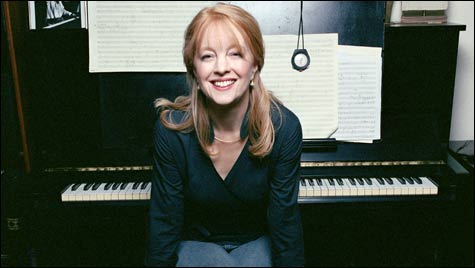
RECIPROCAL MAGIC: Schneider erases the line between writing and improvisation. |
WFNX’s Jazz Brunch Top 5
1. Josh Roseman, New Constellations: Live in Vienna [Accurate]
2. Herbie Hancock, River: The Joni Letters [Verve]
3. Dee Dee Bridgewater, Red Earth: A Malian Journey [Emarcy]
4. Various Artists, The Harlem Experiment [Ropeadope]
5. Various Artists, Goin’ Home: A Tribute to Fats Domino [Vanguard] |
Maria Schneider didn’t necessarily know what “The ‘Pretty’ Road” was about when she started writing it. She was working, trying to come up with something, and a tune popped into her head — “quite nearly a pop tune,” she says in the liner notes of her most recent CD, Sky Blue (ArtistShare). But for some reason, that melody transported her to childhood, family car trips in the farmland back home in Minnesota. Sounds entered the piece from that childhood — fragments of ’60s pop tunes, the church where she played organ, the song of the Western meadowlark.By now it’s a familiar process for Schneider, whose Maria Schneider Orchestra makes its Boston debut in a Celebrity Series concert at the Berklee Performance Center November 17. “A lot of times I’ll fool around and try to break something loose,” she tells me over the phone from her home in New York City. “I’ll be playing, and all of a sudden my mind is somewhere, and the music becomes a film score to this thought — it’s almost like the music channels up that memory — and then all of a sudden I’m like: ‘Okay, I’m going to write about this.’ It’s a back-and-forth process between me doing something consciously once I realize what I’m going for and also trying to get lost in that memory and see what music opens up when I’m there.”

On Sky Blue, that process describes the creation of “The ‘Pretty’ Road,” and also, to some extent, the longest piece on the album, “Cerulean Skies,” which conjures bird songs and migration. The title track was inspired by thoughts of a mortally ill friend. Other pieces are less programmatic: “Rich’s Piece” was written to exploit the talent of tenor-saxophonist Rich Perry, and “Aires de Lando” was her attempt to come to terms with the complex lando rhythm of Peru, which she had recently visited.
“Usually the music is attached to something. ‘Sky Blue’ was about the love for a friend, whatever space I was in at that moment. It wasn’t like it was just another day. It was a profound, auspicious time when you have someone that close to you who is passing.” “Rich’s Piece,” on the other hand, was “just a meditation, imagining Rich’s wistful sound.” Sometimes, music is just about music.
Schneider’s music — whatever it’s about — has been gaining traction, and in 2004 she won a Grammy for Concert in the Garden (ArtistShare). A former student of Bob Brookmeyer and assistant to Gil Evans, she’s been releasing albums under her own name since 1992. But from 1993 to 1998, her own working orchestra took shape in regular Monday-night gigs at the New York club Visiones. That’s where she began to form lasting relationships with saxophonist Perry, clarinettist Scott Robinson, pianist Frank Kimbrough, and guitarist Ben Monder. “I think you need to play that much in order for the composer to be influenced by the players, and for the players to find a way of phrasing the music that’s their own.”
That relationship has fermented a unusual sound — a broad palette of tone colors, open harmonies like cloud banks on the Western plains — and Schneider’s unusual melodies, with their pop-tune directness. Sky Blue shows off her ability to fashion long arcs of music in mini-concertos for her soloists. Trumpeter Ingrid Jensen solos almost continuously on “The ‘Pretty’ Road,” as does Perry on “Rich’s Piece.” And it’s difficult to tell where the writing leaves off and the improvisation begins. Schneider suggests the example of Gil Evans’s writing for Miles Davis. “Sometimes Gil composed the very beginning of the solo and the very end of the solo — it’s taking a little bit of the control of the direction of the piece, so there’s a seamlessness as opposed to ‘Just blow.’ Which most jazz is: the tune’s over and they start blowing, and it’s very clear when that happens. But what attracted me to writing for jazz musicians in the first place was this idea of intimacy — that the music belongs to both of us, that the improvisation is woven into the written music and I’m not just creating some background for everyone to blow on. I enhance what they do and they enhance and give freedom and breath to the things that I do.”
Guitarist John Stein says he’s reissuing his second album, 1999’s Green Street, for a very simple reason: “I ran out of copies. People were asking me for copies and I didn’t have any to sell.” Rights to the album had reverted to Stein from the original label, so he cut a deal with his current label, North Dartmouth’s Whaling City Sound, and went back to the mixing board with original engineer Peter Kontrimas.